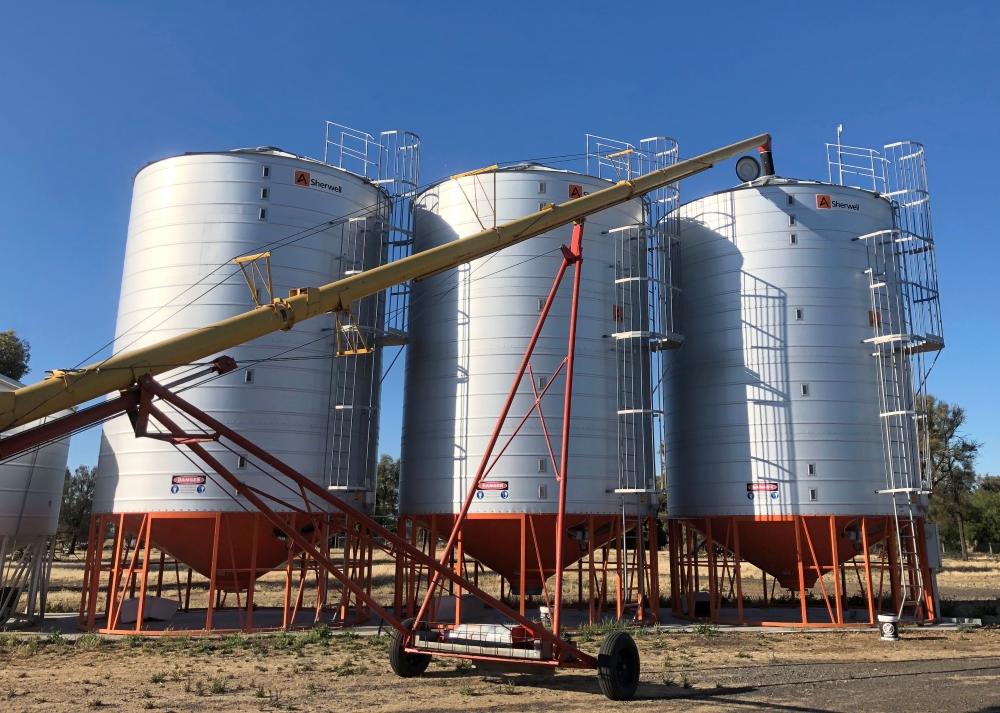Paddock Practices: Grain protectant guide for growers ahead of storage
Paddock Practices: Grain protectant guide for growers ahead of storage
Date: 20 Oct 2020

Grain storage specialists are encouraging growers who are planning to store grain on-farm this season to consider using protectants to reduce the risk of insect infestations.
The use of protectants combined with good hygiene, aeration cooling and regular grain inspections are key tools for protecting grain quality.
Grains Research and Development Corporation (GRDC) Grain Storage Extension Project manager, Chris Warrick, is encouraging growers to consider protectants post-harvest on cereal grains, where appropriate.
Mr Warrick says grain protectants are designed to prevent pest infestations, not to control infestations, so ideally they should be applied at harvest time as grain is augered into storages.
Mr Warrick advises growers to develop a clear marketing strategy before treating grain with protectants, so they avoid using these chemicals if it was likely to cut themselves out of potentially profitable domestic or export markets, such as pesticide residue-free (PRF) markets.
When to use grain protectants
- Typically, protectant sprays are applied to cereal grain at harvest time as grain is augered into storages. They provide grain protection for three to nine months. Protectants control insects as they invade the grain during storage and control the immature stages (eggs, larvae or pupae) of these insects.
- Become familiar with the stored product pests you may expect to see – for support view the Stored Grain Pests Identification – The Back Pocket Guide. If you see anything unusual, report it to your local state department of primary industries or phone the Exotic Plant Pest Hotline, 1800 084 881.
- When live insects are detected in grain during monthly storage inspections, fumigation in a sealable silo is required for effective control. Grain protectant sprays are not designed to nor will they reliably disinfest grain after an infestation is found.
- With many domestic and export markets seeking grain supplies which are PRF, always talk to potential grain buyers/traders prior to applying grain protectant sprays.
- No protectant sprays can be applied to pulses or oilseeds.
Common ‘on-farm’ uses for grain protectants
- Planting seed held on-farm.
- Grain held for an extended time in non-sealable storages (not suited for fumigation) and when the grain buyer has agreed to grain protectant use that is in line with directions for use on the registered product label.
- Grain held on-farm as feed for livestock with agreement from livestock agent or buyer and is in line with directions for use on the registered product label.
Grain protectant choices

Examples of two products, which includes an organophosphate (OP) partner product, to control the main storage pest species:
1. Conserve Plus™ Grain Protector: 100 g/L spinosad, 100 g/L s-methoprene. Used in combination with a compatible OP product such as chlorpyrifos-methyl (ReldanTM), or fenitrothion.
For label and application information, see Corteva’s website – Conserve Plus™ Grain Protector.
Key recommendations
- Always add chlorpyrifos to Conserve Plus to include protection against the rice and maize weevil (Sitophilus spp.).
- Calibration of spray equipment and care with application are critical to achieve the correct dose. A grain auger, rather than a belt tubeveyor, provides the mixing to achieve uniform spray coverage on grain.
- If Conserve Plus treated grain is exposed to light, for example a semi open grain shed, cover the grain surface with a tarp or 80-90 per cent shade cloth. Sunlight breaks down Conserve Plus over time.
- Only one application of Conserve Plus can be applied to a parcel of grain, so maximum residue limits (MRLs) are not exceeded. For more information go to Corteva’s web site and seek advice when purchasing Conserve Plus.
2. K-Obiol® EC Combi, synergised grain protectant: 50 g/L deltamethrin, 400 g/L piperonyl butoxide. Used in combination with an OP partner, e.g. chlorpyrifos-methyl (ReldanTM), or fenitrothion.
For label and application details on product use, see Bayer’s website – K-Obiol® EC Combi.
Key recommendations
- To include protection against rice and maize weevils (Sitophilus spp.), add a recommended OP partner (e.g. chlorpyrifos-methyl or fenitrothion) to the tank mix.
- To ensure effective pest control and that MRLs are not exceeded, calibrate spray equipment to achieve correct dose rate and aim for uniform coverage on grain.
- Only one application of K-Obiol can be applied to a parcel of grain, so MRLs are not exceeded
- Growers are required to complete a brief (approximately 60 minutes) online training course to be an ‘approved user’ prior to purchase of K-Obiol® EC Combi. See Bayer’s website.
Insect resistant management
If possible, rotate chemical active ingredients used for storage pest control at your storage facility. Example, for one or two years use Conserve Plus™ product, followed by one or two years of K-Obiol® EC Combi.
Please read and follow all label recommendations and ensure that the product is registered for use in your State prior to application of any product.
Always keep grain storage records to ensure accurate information is on commodity vendor declarations (CVD).
Application of grain protectants
Grain protectant application requires care to achieve the correct dose and uniform grain coverage. This leads to effective pest control results and ensures MRLs are not exceeded.
- Know your auger’s grain transfer rate. Ensure you have a good understanding of the grain flow rate, tonnes per hour, for the height the auger will be operating.
- Calibrate your spray application unit with water and check appropriate nozzles and spray pressures are used to achieve the required application of one litre of spray mixture per tonne of grain.
For more information go to the GRDC’s stored grain information hub.
GRDC Project Code: PRB1507-001SAX,
